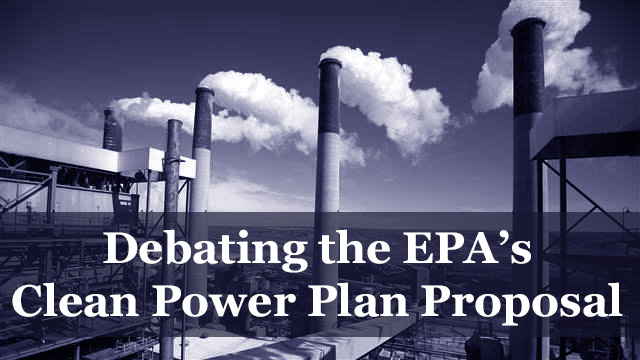Editor’s Note: The post is part of a discussion on the EPA’s Clean Power Plan proposal between Philip Wallach, a fellow in Governance Studies at Brookings and the author of the upcoming book, Legality, Legitimacy, and the Responses to the Financial Crisis of 2008 (Brookings Press, 2015), and Bob Sussman, former senior policy counsel to the EPA administrator.
In their Washington Post Wonkblog and accompanying explainer, Brookings Fellow Philip Wallach and Alex Abdun-Nabi take the EPA to task for the state-by-state emission reduction goals in its recently proposed Clean Power Plan. These goals, they argue, are not “fair,” will result in “the unequal distribution of regulatory costs,” and seem “arbitrarily imposed from on high.”
There’s certainly room to debate the EPA’s state-by-state goals. The rulemaking process will provide an opportunity to voice concerns and EPA may make adjustments in its final allocation of responsibilities. But the EPA should receive credit for a thoughtful, data-driven, and analytical approach to a difficult problem. Suggesting that the state-by-state goals lack any guiding logic or rationale and that they reflect political judgments the EPA is not equipped to make does a serious disservice to the agency’s carefully framed and documented proposal.
The EPA’s Framework: Building Blocks
The Clean Power Plan is rooted in section 111(d) of the Clean Air Act, which authorizes “standards of performance” for industrial sources of pollution such as greenhouse gases (GHG) that contribute to climate change. Under the act, these standards are to be developed and implemented by the states. The EPA’s job is to provide a framework that defines the level of emissions reduction that the states must achieve and the tools they can use to get there.
For power plants, the EPA defined this framework broadly in keeping with the integrated nature of the electricity distribution system. It thus examined not just improvements in individual power plants but also system-wide changes in how electricity is produced and used that could reduce the power sector’s GHG footprint.
This analysis led the EPA to identify four “Building Blocks” (or emissions reduction strategies) that were practical and cost-effective:
- Block 1: Improving the efficiency of coal-fired power plants;
- Block 2: Increasing the utilization of natural gas plants and lowering power production by coal plants;
- Block 3: Displacing fossil-fuel generation with non-emitting power (renewables and nuclear);
- Block 4: Reducing power plant output by cutting demand for electricity through more efficient use of energy in homes and businesses.
The EPA then had to translate these Building Blocks into emissions reduction targets or “goals” for which states would be held accountable. It could have adopted a “one size fits all” approach, under which all states would be subject to an identical carbon intensity target or would need to reduce emissions by a uniform percentage. But this approach would have been attacked as arbitrary and unrealistic.
The EPA chose instead to develop individualized state-by-state goals reflecting the wide differences among the states in their mix of coal, gas, and nuclear power generation, reliance on renewable energy sources, electricity market structure, and previous efforts to reduce electricity demand. To implement this approach, it created a 2012 baseline for each state and then “looked ahead to what reasonably could be accomplished by 2030 . . . if states made practical and affordable changes to generate electricity without emitting as much CO2.” This involved determining the state’s ability to reduce emissions using each building block and then totaling up these reductions to calculate a composite emission rate (or carbon intensity) target for the state. The EPA has stressed that the state goals are “fair and equitable . . . because th[is] formula is applied uniformly.”
Low Targets for Big Emitters: Easy Pass or Equal Work?
But does the formula produce unfair or counter-intuitive results? Wallach and Abdun-Nabi claim that the EPA “asks the least from states that pollute the most.” This claim involves three states – West Virginia, Kentucky and North Dakota – that derive virtually all their power from coal-fired power plants (and are also large producers of coal). These states don’t have the ability to use Building Block 2, shifting utilization from coal to gas-fired generation, because they lack gas-fired plants that can operate at a higher utilization rate and pick up the slack from coal plants. This necessarily constrains their ability to reduce emissions.
Nonetheless, recognizing that other Building Blocks may apply, EPA has not let them off the hook, but required reductions in carbon intensity of 11 percent (North Dakota), 18 percent (Kentucky) and 20 percent (West Virginia). These reduction levels are in fact comparable to those EPA has set for three states with the lowest carbon intensity in the nation – California (23 percent), Maine (14 percent), and Rhode Island (14 percent). Why? These states lack coal-fired generation and don’t have the ability to reduce emissions by ramping down coal plants and ramping up gas plants. Thus, contrary to the piece by Wallach and Abdun-Nabi, the EPA has required similar levels of reduction by the highest- and lowest-emitting states because they are both constrained in their ability to lower fossil-fuel emissions.
Wallach and Abdun-Nabi imply that the EPA is easing the burden on the three coal-reliant states in a misplaced hope that they may soften their political attacks on the agency’s rule. But the EPA’s leadership is not that naïve and in fact the congressional representatives of these states have been leading the charge to derail the EPA rulemaking. The simple fact is that the intensity goals for these states are an outgrowth of the methodology the EPA created to construct its rule, not the expression of a political agenda.
They also argue that, in contrast to the three coal states, the EPA is penalizing the many states with a mix of coal and gas generation by requiring them to make deeper reductions. These states, which account for the great bulk of U.S. GHG emissions, include Colorado, North Carolina, Georgia, Ohio, Michigan, Maryland, Minnesota, Illinois, Texas, Tennessee, Wisconsin, Virginia, and Pennsylvania. They now have roughly similar levels of emission intensity and would need to make comparable intensity reductions (in the range of 30-40 percent) under the EPA’s proposal. As a result, they would have lower carbon intensity than coal-only states but higher intensity than states lacking any coal generation.
Are these states being treated unfairly? To take advantage of the low cost of natural gas, they have closed coal plants and built new gas capacity but they continue to have many coal plants with high emissions. The EPA’s analysis shows that more fully utilizing gas plants and scaling back coal plant operation under Building Block 2 will reduce these emissions cost-effectively. Thus, these states have greater flexibility than coal-only states to shift power generation away from coal. Isn’t it reasonable to set goals which take advantage of this flexibility but allow some continued reliance on coal?
Turning to Building Block 3, the EPA’s state goals assume that all states will increase their reliance on renewable power but at different rates. As the EPA points out, “the type and extent of current RE (Renewable Energy) capacity varies significantly across states, and is influenced by the renewable resources available, the economics of the power sector to date in different regions, and the state policies that affect renewable resources specifically and energy production generally.” The agency has used these factors to derive state-by-state targets that represent a “reasonable benchmark of regionally cost-effective RE generation which states could grow towards over time.”
Wallach and Abdun-Nabi suggest that the EPA is penalizing states that have already made large strides in renewable energy by subjecting them to even more stringent targets. The reality is more complicated. The targets for currently high-performing states are either below their existing RE levels (Iowa, Maine, Minnesota, and South Dakota) or require modest RE growth (California, North Dakota, Idaho). The most ambitious targets are for states that are lagging well behind regional leaders but have adopted aggressive goals (Colorado, Massachusetts, Nevada, New York, New Mexico, New Hampshire, and Washington). Holding these states to their own goals is hardly unfair or unreasonable. If there’s a problem, it is that the EPA has been too lenient toward states with a poor record of promoting renewables and should spur them to be more aggressive in its final rule.
Legislate or Regulate: Complexity Happens
Wallach and Abdun-Nabi compare the “mind-boggling complexity” and “bureaucratic accommodation” of the EPA’s rulemaking with the supposed rationality and simplicity of legislation. But Congress’s last tussle with climate change, the 2009 Waxman-Markey cap-and-trade bill, was easily as complex as the EPA rulemaking and, despite many political compromises, met an ignominious fate in the Senate. Now, with Congress in a state of gridlock, the odds of congressional action on climate change are impossibly long and will almost certainly remain so. EPA rulemaking poses many challenges but it offers the only prospect for meaningful GHG reductions from power plants, by far the largest emitting sector. We should give it a fair hearing. The state goals in EPA’s proposal are indeed controversial, as any effort to differentiate among states would inevitably be, but they reflect a rigorous methodology — transparently and impartially applied.
Bob Sussman is the principal in Sussman and Associates. He recently completed four and a half years of service in the Obama administration, first as co-chair of the Transition Team for the EPA and then as senior policy counsel to the EPA administrator. He was a senior fellow at the Center for American Progress in 2008, writing and speaking about climate change and energy. In 2007 he retired as a partner at Latham & Watkins. He previously served in the Clinton administration as the EPA deputy administrator, chief operating officer, and regulatory policy officer.
The Brookings Institution is committed to quality, independence, and impact.
We are supported by a diverse array of funders. In line with our values and policies, each Brookings publication represents the sole views of its author(s).




Commentary
Debating the EPA’s Clean Power Plan Proposal — EPA’s State Goals for Reducing Carbon Pollution from Power Plants: A Thoughtful and Fair Solution to a Complex Problem
July 29, 2014